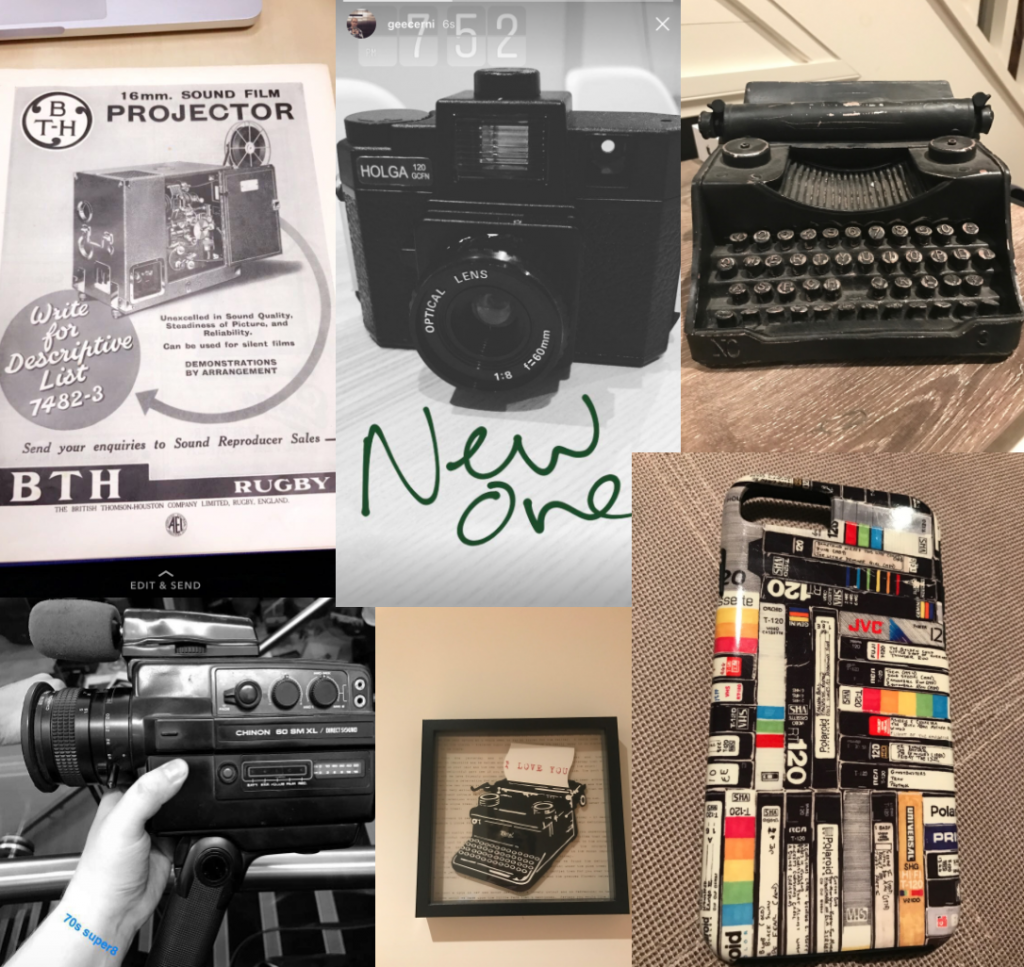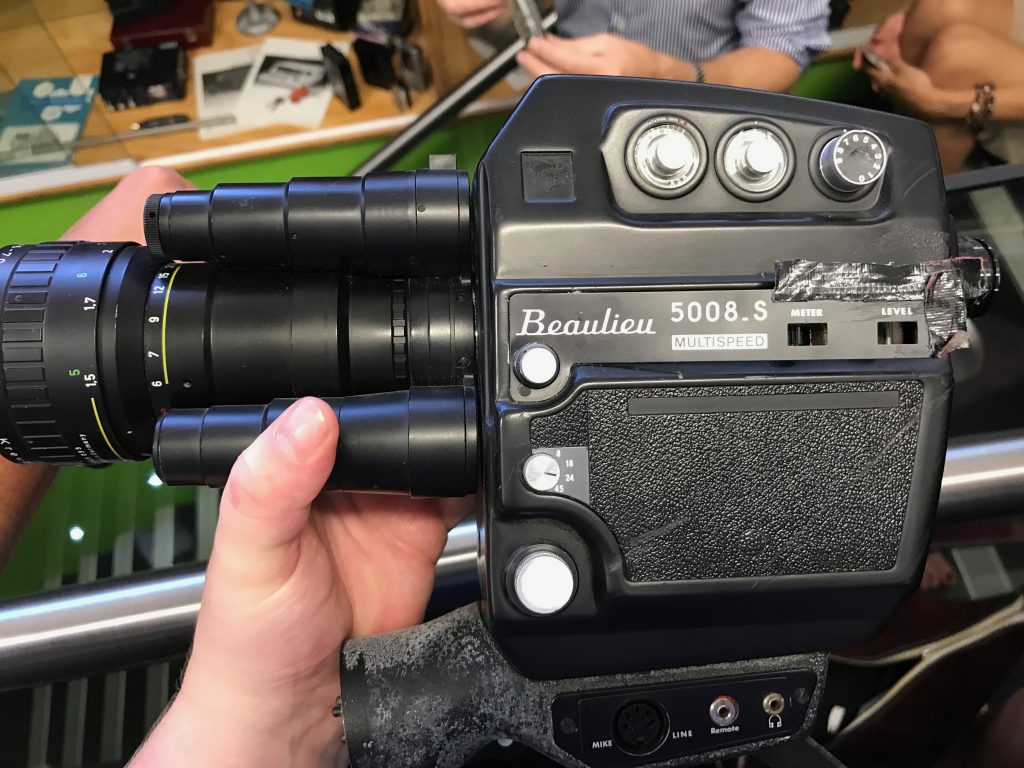There is an aesthetic attraction to old media.

This collage shows different instances of my own admiration of old media technology both on social networking platforms and for decorative use. This reflects the idea that in my case, my preoccupation with older, analogue technology is rooted in an appreciation for the aesthetic component of the technology. This suggests that it is not so much nostalgia that drives interest in older technologies, but rather a more superficial appreciation for the look and feel of these items. We can see this is the case as I have uploaded images of these technologies to social media, putting filters on the images in order to showcase their visual appeal. I have also included technologies which I have never used, for example the typewriter. This suggests my interest in this object is not so much nostalgic in terms of associating myself or my past with this technology, but rather my admiration is more so rooted in a materialistic, aesthetic appreciation.
Nokelainen argues that “if a displaced technology continues to enjoy market presence… the salient reasons have to do with aesthetic considerations rather than functional ones.” (p. 9, 2015) In other words when we consider the Holga film camera which we can see pictured above, my own interest in this technology likely has less to do with the functional capabilities of the technology (I could take higher quality images with my iPhone) or the functional convenience of the camera (my iPhone can fit in my pocket; this camera cannot) but rather my interest is associated with appreciation for the aesthetic qualities of the camera, both as an object and for the images that it produces.
While I argue that aesthetic value is a key contributor to appreciation for older technology, it can also be seen that wider sensory experience and nostalgia have a role in our interest with older technologies. However, it can be shown that aesthetics are inextricably bound up within these elements. Berry explores the popularity of “faux – vintage” filters on smartphones, which she argues “[use] heritage aesthetics to go beyond visual sense to interpret aspects of .. the whole sensorium experience.” (2014). She suggests these filters are also markers of “nostalgia for a sense of place”. (2014) I take this to mean that aesthetic considerations create a nostalgic feel. I liked the build of the camera and its overall look but the appeal may have also been in my association with this camera as representing a bygone era, hence the black and white filter.
We can see fascination with aesthetic components of old media reflected in the resurgence of analogue mediums like the vinyl record. Yochim and Biddinger note a collector’s opinion that the absence of vinyl would mean “the world wouldn’t be as pretty”. (p. 192, 2008) Similarly, Fonarow noted in a study of indie music fans that fascination with vinyl was about the audio aesthetics, “the scratches and minor skips” as well as other “sensual qualities” like album artwork and the vinyl sleeve. (p. 60, 2013)
While it would be naive to assume that nostalgia is irrelevant when it comes to preoccupation with older technologies, I argue that aesthetic considerations play a major role in the fascination with and resurgence of older media, like the film camera and the vinyl record.
References
Fonarow, W 2013, ‘Empire of Dirt’ , Wesleyan University Press, Middletown. Available from: Proquest eBook Library. [25th March 2017]
Yochim, E & Biddinger, M 2008, ‘”It kind of gives you that vintage feel”: Vinyl records and the tripe of death.’ Media, Culture & Society, vol. 30, no. 2. Available at: Old’s Cool Media Factory Blog. [Accessed: 20th March 2017]
Barmanski, D & Woodward, I 2015, ‘Vinyl: the analouge record in the digital age’, Bloomsbury Publishing PLC, London. Available from: ProQuest eBook Central. [Accessed: 25th March 2017]
Nokelainen, T & Dedehayir, O 2015, ‘Technological adoption and use after mass market displacement: The case of the LP record’, Technovation, vol. 36 – 37, pp. 65 – 76. Available at: Science Direct. [Accessed: 25 March 2017]
Berry, M 2014, ‘Re-imagining place with filters: More than meets the eye.’ Journal of Creative Technologies (MINA Special Issue), 4, 81-96. Available at: https://ctechjournal.aut.ac.nz/paper/re-imagining-place-filters-meets-eye/#tabs=0 [Accessed 24th March 2017]






 There's a few different things involved in the process of sculpting clay.
- Start with fresh clay, a black canvas and then other clay is added onto it to form different shapes i.e. the hair on this guy ^
- Clay is removed with a cutting/scraping tool for precision, artist constantly manoeuvres around clay
- To maneuver with clay, water is added to soften it up
source: http://www.figurines-sculpture.com/sculpture-technique.html
Stained glass window
There's a few different things involved in the process of sculpting clay.
- Start with fresh clay, a black canvas and then other clay is added onto it to form different shapes i.e. the hair on this guy ^
- Clay is removed with a cutting/scraping tool for precision, artist constantly manoeuvres around clay
- To maneuver with clay, water is added to soften it up
source: http://www.figurines-sculpture.com/sculpture-technique.html
Stained glass window
